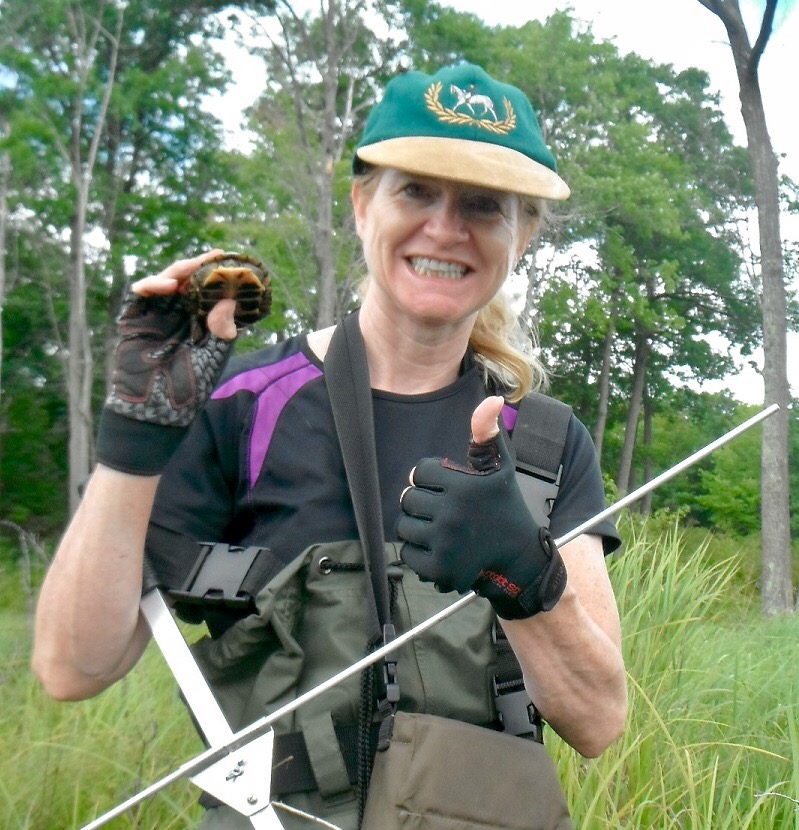Faces of the TSA Vol. 6
by Jordan Gray

Who: Dr. Sue Carstairs
What: Executive and Medical Director, Ontario Turtle Conservation Centre
Where: Peterborough, Ontario, Canada
Jordan Gray: What is your earliest childhood memory with a turtle or tortoise?
Sue Carstairs: I always had turtles and tortoises as pets as a child, and have great memories creating ponds and other habitats outside for them. In fact, I preferred that to anything else. Even then, I found it very frustrating that there wasn't more "research-based" information pertaining to their care. Nobody seemed to have the answers to my questions - especially veterinarians!
JG: What is your favorite species of turtle or tortoise to work with?
SC: I try not to have favorites, but it's well known that I have a very soft spot for Blanding's Turtles (Emydoidea blandingii). Perhaps this is because we see so many of them at the Kawartha Turtle Trauma Centre (KTTC), and I feel we can make a direct impact for them here in Ontario. Also, they are so easy to head-start, and don't eat each other's tails like the snapping turtles like to do!
JG: How did you first become involved in turtle and tortoise research and conservation?
SC: Although I worked as a vet with a myriad of wildlife species for 20 years, I was searching for a project that was based in conservation, and in which I would have a real impact. Since road mortality is second only to habitat loss as causation for population declines of the turtles in Ontario, assisting in mitigating these mortalities seemed to be the perfect way to combine my veterinary skills with my passion for conservation. By good fortune, 10 years ago, the KTTC was looking for someone to take over as Executive Director, and I happened to be at the right place at the right time. Once involved with the hospital, the hatchling program became a natural extension of this, since approximately half of the turtles admitted are gravid (egg laden) females. The incubation of these eggs and rearing of the hatchlings seemed like a logical extension for our conservation goals. Our field studies to radio-track a group of these captive-hatched turtles, alongside a group of their wild-hatched counterparts, became a natural extension of the head-start project. I felt it was important to assist in establishing best practices for this effort, and to assist in determining if this was a viable conservation strategy for the species we work with. Because we were putting a lot of our resources into the head-start program, it only made sense to ensure that this strategy had merit.
JG: Who is your biggest inspiration in the field of wildlife conservation and why?
SC: That's a tough one, as there are so many. I am reluctant to mention just a few, because I learn from everyone; I would have to list hundreds of individuals and I don't want to leave anyone out! From the well-known and very public ones that I read about as a child, to the up-and-coming ones that are working hard in the field now, they have all inspired me. To name just a few would be impossible!
JG: What is the most amusing situation you have found yourself in, in the field?
SC: I guess the one that gets mentioned the most, that is funny in hindsight, is the week in the field in which most people who rode in tandem with me in the canoe ended up in the water! The now-famous quote by one canoe-mate as I lunged over the side to grab a turtle, flipping the canoe as a result, was, "I kinda thought you'd use the net!?". That was the trip that Monte Hummel (President Emeritus of WWF), decided to join us. The look of horror on the rest of the team's faces when he said, "I think I will ride with Sue", still makes me laugh. That being said, I was very, very careful with him! For some reason, he has been of great support to us ever since, and told that very story at our most recent fundraiser.
JG: If you weren't a Doctor of Veterinary Medicine, what would you want to be?
SC: I am very lucky to be able to combine my passion for conservation with my veterinary medicine degree. If I was not a vet, I would still be involved in wildlife conservation; I also have a degree in wildlife, so I would have continued with that track. With the blossoming field of Conservation Medicine, we are all a part of this in some way, so whatever angle you approach it from, is valuable.
JG: What advice would you give to an aspiring chelonian conservationist?
SC: Get involved in projects wherever you can; volunteer, and this will always lead to something good. Once you get to know people out there, doors open, and it will become easier to be an integral part of conservation.
JG: What attracted you to become part of the Turtle Survival Alliance?
SC: I admire TSA's commitment and drive. I love the way they have the ideal – "Committed to zero turtle extinctions", as their goal, period. I also greatly respect their multi-pronged approach to conservation, and their recognition that all facets are important, especially education. This is very much my own approach; you cannot approach conservation from just one angle and hope to solve the problem. The TSA has sound evidence-based science as their foundation, which is fundamental for long-term conservation measures. The diverse array of projects that they are involved in throughout the world, and the extremely high-standards that they have for each project is impressive!
